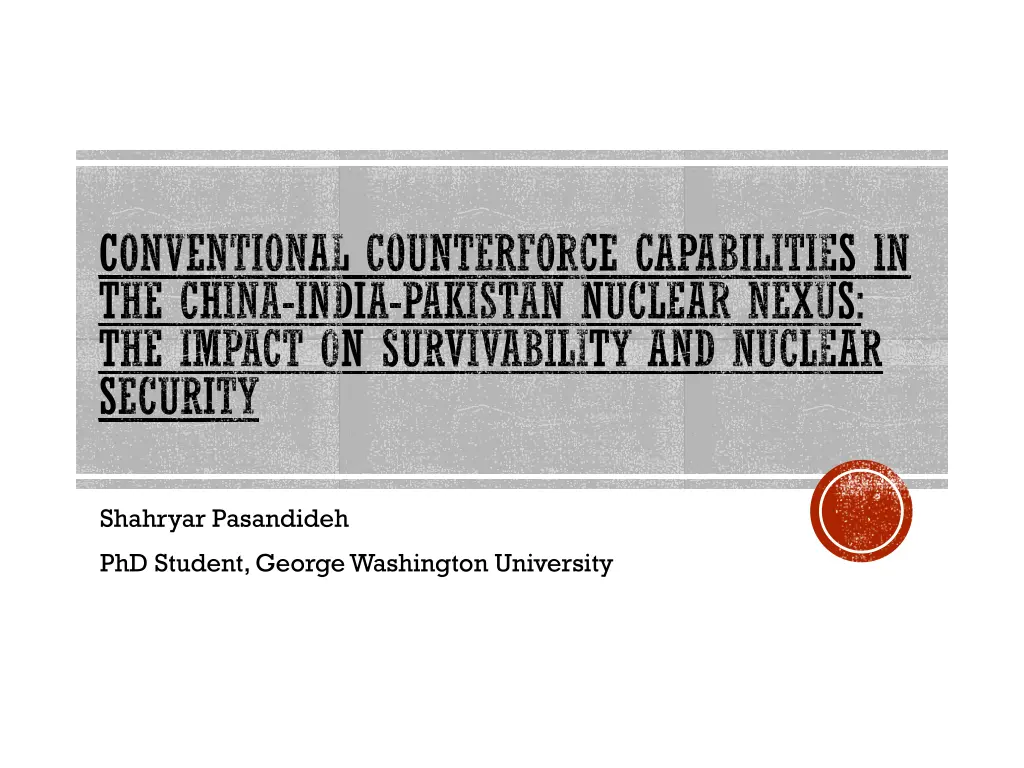
Impact of Conventional Counterforce Capabilities on Nuclear Security in China-India-Pakistan Nexus
Explore the impact of conventional counterforce capabilities on the survivability and security of nuclear forces in the China-India-Pakistan nexus, analyzing the interaction between conventional and nuclear developments, arguments, land-based missile launchers, and case studies on Pakistan's Nasr missile. Consider the challenges, vulnerabilities, and implications for stability and security in the region.
Download Presentation

Please find below an Image/Link to download the presentation.
The content on the website is provided AS IS for your information and personal use only. It may not be sold, licensed, or shared on other websites without obtaining consent from the author. If you encounter any issues during the download, it is possible that the publisher has removed the file from their server.
You are allowed to download the files provided on this website for personal or commercial use, subject to the condition that they are used lawfully. All files are the property of their respective owners.
The content on the website is provided AS IS for your information and personal use only. It may not be sold, licensed, or shared on other websites without obtaining consent from the author.
E N D
Presentation Transcript
CONVENTIONAL COUNTERFORCE CAPABILITIES IN THE CHINA-INDIA-PAKISTAN NUCLEAR NEXUS: THE IMPACT ON SURVIVABILITY AND NUCLEAR SECURITY Shahryar Pasandideh PhD Student, George Washington University
THE INTERACTION OF CONVENTIONAL AND NUCLEAR DEVELOPMENT Continued horizontal and vertical nuclear development Simultaneous conventional force development Recent academic research suggests vulnerability of Soviet/Russian mobile nuclear assets to U.S. conventional counterforce How secure are the nuclear forces of India and Pakistan from adversary conventional counterforce capabilities? What is the impact of increased survivability on nuclear security?
ARGUMENTS Unfavourable prospects for conventional counterforce against mobile nuclear forces deployed operationally Garrisoned mobile nuclear forces increasingly vulnerable to precision conventional munitions Good news: more survivable forces may increase stability by calming arsenal development Bad news: Increased survivability only if actively deployed in the field during peacetime Risks: nuclear and non-nuclear accidents, terrorism, and impact on command and control
LAND-BASED MISSILE LAUNCHERS India and Pakistan both primarily rely on mobile land-based ballistic missiles with Pakistan also using cruise missiles No silos Pakistan s missiles are aimed at India while India s are based at Pakistan and China Reliable information on garrisons not publicly available But size of launch vehicles likely means they are kept in: Hardened garages Underground bunkers Regular garages Given importance, regular garages unlikely
CASE STUDY: PAKISTANS NASR MISSILE I Nasr garrisons unknown but open source reports allege sites Launch unit organization not known One alleged facility near Gurjanwala, Punjab just ~65 km from India Nasr has reported 60 km range Reported doctrinal role: attack invading Indian units
CASE STUDY: PAKISTANS NASR MISSILE II Satellite imagery shows concrete garages Quite robust but vulnerable to precision munitions Current air threat from India limited but developing Current India cruise missile threat Mach 2.5+ BrahMos Can hit alleged garrison in 5.5 minutes India likely only able to attack Nasr in garrison not outside Impact: Pakistan may deploy Nasr outside garrison, decreasing stability and risking counterforce strikes.
CASE STUDY: PAKISTANS NASR MISSILE III Nasr launchers outside garrisons comes with risks: Launcher breaks down/immobilized/crashes into traffic (poor road network) Trade-off between survivable against India/militants Risk of inadvertent destruction by India if same missile/launch vehicle used for other roles Poor topography and geography Inadvertent nuclear detonation are Pakistani warheads one-point safe?
CASE STUDY: PAKISTANS NASR MISSILE IV Will Nasr be at high readiness in garrison? Will Nasr be scrambled out of garrison during crises? Will some nuclear-armed Nasr bet out of garrison regularly? Improves survivability, reduces security, and very escalatory Consider impact on command and control for all scenarios
CASE STUDY: INDIA MISSILE GARRISONS I Locations not publicly available Likely also garrisoned in hardened garages and/or underground bunkers India understood to store warheads and missiles separately But how proximate? Not clear. Apparently no field patrols Risk of decoupling: if warheads and missiles separate and distant, warhead- less missiles more vulnerable
CASE STUDY: INDIAS MISSILE GARRISONS II Important caveat: no reason to believe Pakistan or China would undertake such a conventional strike against warhead-less missiles But theoretical vulnerability can lead to countermeasures Full-time mating of warheads and missiles? Launchers with warheads outside of garrisons? Can result in change of nuclear posture
CASE STUDY: INDIA MISSILE GARRISONS III How credible is conventional counterforce threat? India s air defense has gaps but improving No ballistic missile defence and weak cruise missile defence Chinese ballistic and cruise missiles very capable Pakistan air force and ballistic missiles not serious threat Babur land-attack cruise missile is But Babur is subsonic 45 minutes to go maximum range of 700 km Threat from China much more serious and credible in theory but much less likely in reality But India s nuclear posture is increasingly oriented towards China
CASE STUDY: INDIA MISSILE GARRISONS IV Like Pakistan, India can improve survivability by deploying outside garrisons but at cost of less security Many of same risks as Pakistan: Vehicular accidents Launch vehicle non-ubiquity Risk of inadvertent nuclear detonation on soil hostile or accident Worse than Pakistan: more distributed population density and less uninhabited land Unlike Pakistan India has early warning system How would it deal with warhead ambiguity?
TAKEAWAYS Trade-off between nuclear force survivability and nuclear security In the second nuclear age, conventional counterforce in second- tier nuclear dyads may apply similar pressures on second strike capability development as did nuclear counterforce capabilities in past The operational aspect of the conventional military balance not just quantitative balance of forces may greatly impact nuclear development trajectories India s development of a new nuclear capability may lead Pakistan to do the same What India develops with China in mind, Pakistan may follow Example: Pakistan following India in developing a submarine- based nuclear capability





















